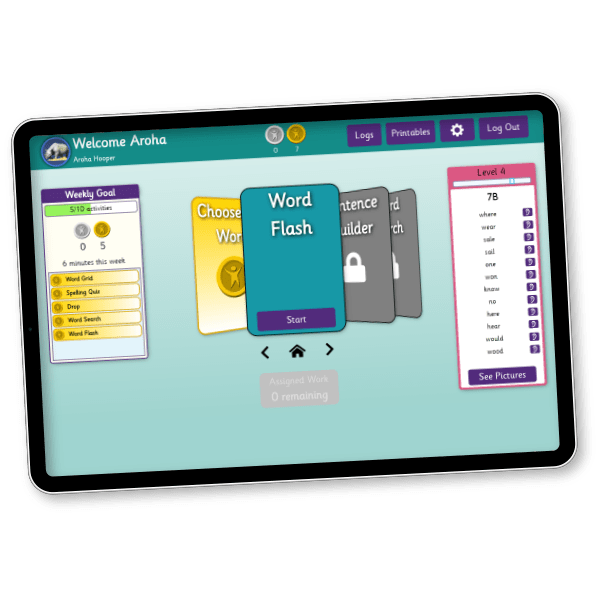The Visual Recognition Test measures how many milliseconds it takes a reader to visually recognise a known word. To understand the significance of this, we recommend reading through this information on the stages learners go through when learning to read.
In 1985, the psychologist Uta Frith proposed the Three Stages of Learning to Read model shown here. There has been considerable research into this area over the last few years and this has given us far more detail into this process. However, the original three-phase model is still widely regarded by experts as a useful outline of what the brain experiences (Dehaene, 2009).
This stage is regarded as a very visual, pictorial stage, where a child’s brain retains an image of a word, but doesn’t yet understand letter-sound correspondence.
In this stage, a learner may recognise a tiny number of significant words – their name, for example - from the word’s overall shape. They’re likely to confuse similar-looking words and would not be able to decode an unknown word, as they don’t yet understand letter-sound correspondence.
The main reading strategy in this stage is visual recognition of words.
This stage is where the learner is developing phonemic awareness and phonic knowledge. Students learn to apply these to decode and encode unknown words. They can be expected to read unknown words – providing they are reasonably regular – and write unknown words.
Errors are likely to be phonetically correct:
In this stage, the main strategy for reading is conscious decoding, using the main decoding areas of the brain, particularly Broca’s Area and the parietal-temporal area.
This is the final stage in reading, where a fluent reader is able to recognise words instantly. The words have been stored in the occipito-temporal area of the brain, often known as the Visual Word Form Area, and they can be retrieved instantly without conscious decoding.
When an unknown word does occasionally pop up, the reader has the phonological skills and phonic knowledge to decode it with no difficulty. The word is then stored in the Visual Word Form Area and the next time it’s seen, it will be instantly recognised.
Research has identified that some struggling learners, particularly those with dyslexia, fail to transition from conscious decoding to using the Visual Word Form Area. Good phonics-based instruction may well produce a good decoder, but the student may still fail to become a genuinely fluent reader. This has massive implications for literacy in general.
The ‘cognitive overload’ of reading by conscious decoding means that readers:
With learners in this category, the transition between stages is not an automatic one. It is important to:
StepsWeb includes a test which measures how many milliseconds it takes to visually recognise a known word. This test was developed in conjunction with the University of Auckland.
Supporting research in this field shows that instant visual recognition of words happens in a fraction of a second, whereas conscious decoding is a slower, labour-intensive process. Some studies have indicated that being able to recognise a word in around 150ms or faster is a clear indicator that the reader is using the Visual Word Form Area of the brain and there is much on-going research in this field at present.

The test enables a teacher to track a learner’s progress and identify when they transition to using the Visual Word Form Area of the brain for instant visual recognition. As a guide, a fluent reader should be able to recognise words at 50-150 ms.
The test development has identified what visual recognition speeds are normal at different ages. Obviously a young learner has to go through the three phases of reading and their speed will normally develop as part of this process.
The research done also found that visual recognition speed may be used as a valid predictor of students who may have difficulty reading.
![Auckland Uni logo blue]](https://www.stepsweb.com/hubfs/Auckland%20Uni%20logo%20blue%5D.png)
The StepsWeb development team collaborated with researchers from the University of Auckland (UoA) to validate the Visual Recognition Test as a tool for identifying learners who are likely to struggle with literacy.
The UoA researchers carried out an analysis of the StepsWeb Visual Recognition Test and published an academic report which assessed its validity in 2017.

The test can be set by a teacher at any point. However, StepsWeb automatically analyses visual recognition speed as a student works on the programme and their current visual recognition speed is shown in the student profile. This feature also adjusts the speed of the Word Flash activity, which is designed to develop visual recognition speed. This means that it is not even necessary to set the formal test.

StepsWeb delivers a structured, research-based approach to teaching literacy. Explore the methodology behind the leading online literacy programme.

The specialist approach which can be used by non-specialists.
StepsWeb stands out because it works on many levels. Research shows the need for a structured literacy approach – particularly with struggling learners.
StepsWeb provides a structured, cumulative approach to literacy, which encompasses and develops the six key elements often referred to as the Big 6 of Literacy. (Konza, 2014)

StepsWeb supports struggling learners by providing a research-based, structured approach to literacy. Ideally, this should be an approach which enables every learner to progress at his or her own speed and level...
Want more helpful resources and information like this? Subscribe to our newsletter below for monthly updates and the occasional freebie.